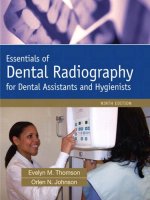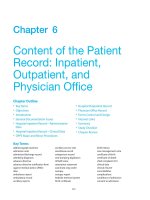Ebook Essentials of mechanical ventilation (3/E): Part 2
Bạn đang xem bản rút gọn của tài liệu. Xem và tải ngay bản đầy đủ của tài liệu tại đây (16.13 MB, 300 trang )
Chapter23
CardiacFailure
•Introduction
•Overview
Heart-LungInteractions
EffectsofMechanicalVentilation
PositiveEnd-ExpiratoryPressure
•MechanicalVentilation
Indications
ContinuousPositiveAirwayPressure
VentilatorSettings
Monitoring
Liberation
•PointstoRemember
•AdditionalReading
Objectives
1.Describetheeffectsofpositivepressureventilationonheart-lung
interactions.
2.Listindicationsformechanicalventilationinpatientswithcardiacfailure.
3.Discusstheroleofcontinuouspositiveairwaypressureinpatientswith
cardiacfailure.
4.Discussthemonitoringandweaningofpatientswithcardiacfailure.
Introduction
CardiovasculardiseaseistheleadingcauseofdeathintheUnitedStates.Asa
result,manypatientspresenttotheemergencydepartmentorgeneralpatientcare
unitswithcongestiveheartfailureoracutemyocardialinfarction.Manyofthese
patientsbenefitfromtheapplicationofpositivepressureventilation.
Increasinglytherespiratorysupportisappliednoninvasively.
Overview
Heart-LungInteractions
Thenormalchangesinintrathoracicpressureduringspontaneousbreathing
facilitatevenousreturnandmaintainsadequatepreloadtotherightheart.In
addition,thenegativemeanintrathoracicpressurereducesleftventricular
afterload.Leftventriculardysfunctionwithmyocardialinfarction(MI)orsevere
congestiveheartfailureresultsinincreasedleftventricularpreload,pulmonary
edema,decreasedcardiacoutput,hypoxemia,andwork-of-breathing.Of
particularconcernistheincreaseinbloodflowrequiredbythediaphragmand
accessorymusclesasaresultofventriculardysfunction.Therespiratorymuscles
receiveasmuchas40%ofthecardiacoutputduringstress,whichcanresultina
reductionofbloodflowtoothervitalorgans.
EffectsofMechanicalVentilation
Withpositivepressureventilation,themeanintrathoracicpressureispositive.
Duringinspiration,intrathoracicpressureincreases,whereasitdecreaseswith
spontaneousbreathing.Thisdecreasesleftventricularpreloadandafterload.In
thepatientwithacuteleftventriculardysfunction,thismayenhancethe
performanceofacompromisedmyocardium.Inthehypovolemicpatient,
however,theseeffectsmayfurtherdecreasecardiacoutput.
Theresponseofthecardiovascularsystemtopositivepressureventilationis
dependentoncardiovascularandpulmonaryfactors.Fromapulmonary
perspective,thecomplianceofthelungsandchestwallaffectsthetransmission
ofalveolarpressureintotheintrathoracicspace.Themostdeleteriouseffecton
hemodynamicsoccurswithcompliantlungsandastiffchestwall,whichresults
ingreaterpressureintheintrathoracicspace.Cardiovascularvolumeandtone,
pulmonaryvascularresistance,andrightandleftventricularfunctiondetermine
theeffectofintrathoracicpressureonhemodynamics(Table23-1).
Table23-1DeterminantsofCardiovascularResponsetoPositivePressure
Ventilation
•Cardiovascular
–Vascularvolume
–Vasculartone
–Pulmonaryvascularresistance
–Rightandleftventricularfunction
•Respiratory
–Resistance
–Compliance
–Homogeneityofresistanceandcompliance
PositiveEnd-ExpiratoryPressure
Sincepositiveend-expiratorypressure(PEEP)elevatesintrathoracicpressure,it
reducesvenousreturnanddecreasespreload.Inthepresenceofleftventricular
dysfunctionwithanelevatedpreload,PEEPgenerallyimprovesleftventricular
function.PEEPmayincreasepulmonaryvascularresistance,thusincreasing
rightventricularafterloadanddecreasingleftheartfilling.PEEPmaydecrease
thecomplianceoftheleftventriclebyshiftingtheintraventricularseptumtothe
left.Byincreasingthepressureoutsidetheheart,PEEPmayimproveleft
ventricularafterload.
MechanicalVentilation
Indications
Severeheartfailureleadstohypoxemia,increasedmyocardialwork,and
increasedwork-of-breathing(Table23-2).Mechanicalventilationinthissetting
isindicatedtoreversethehypoxemia,reducethework-of-breathing,and
decreasemyocardialwork.Somepatientswithsevereheartfailuredevelopacute
hypercarbia.Thereforetheinitialtreatmentincludesnoninvasivecontinuous
positiveairwaypressure(CPAP).
Table23-2IndicationsforMechanicalVentilationinPatientsWith
CardiovascularFailure
•Increasedworkofthemyocardium
•Increasedwork-of-breathing
•Hypoxemia
ContinuousPositiveAirwayPressure
TheuseofmaskCPAPinthepatientpresentingwithacuteleftventricular
failureandpulmonaryedemareducesthework-of-breathingandtheworkofthe
myocardium.ItalsoincreasesPao2,decreasesPaco2,reducestheneedfor
intubation,andincreasessurvival.Inmanypatients,CPAPprovidessufficient
unloadingofmyocardialandrespiratoryworkwhilepharmacologictreatment
modifiescardiovascularfunction,avoidinginvasivemanagement.Generally,
CPAPismostusefulinpatientswhoareawake,oriented,andcooperative.Ifthe
CPAPmaskfurtheragitatesthepatient,itshouldberemovedandinvasive
ventilatorysupportconsidered.InitialCPAPsettingsaregenerally10cmH2O
with100%oxygen.
Noninvasiveventilation(NIV)hasalsobeenusedtoavoidintubationof
patientswithacutecongestiveheartfailure.Formanysuchpatients,the
outcomeswithCPAPorNIVareequivalent.ThespecificindicationforNIVis
hypercarbicventilatoryfailurealongwiththehypoxemicventilatoryfailure.
However,NIVshouldbeavoidedinpatientswithacuteMI,hemodynamic
compromise,significantcardiacarrhythmias,anddepressedmentalstatus.In
thesepatientpresentingwithrespiratoryfailure,invasiveventilatorysupport
shouldbeprovidedratherthanNIV.
VentilatorSettings
Sincespontaneousbreathingpotentiallydivertsbloodflowtotherespiratory
muscles,continuousmandatoryventilation(A/C)shouldbeused(Figure23-1).
Eitherpressure-controlorvolume-controlventilationisacceptable.Inspiteof
thepulmonaryedemathatmaybepresentatthetimeofinitiatingventilatory
support,pharmacologictreatmentresultsinrapidresolution.Tidalvolumesof6
to8mL/kgidealbodyweightareusuallyadequatewithrespiratoryratesgreater
than15/mintoachieveeucapnia.Plateaupressureshouldbelessthan30cm
H2O.Inspiratorytimeshouldbeshort(≤1second).FIO2shouldinitiallybesetat
1andthentitratedperSpo2andbloodgases.PEEPof5to10cmH2Oshouldbe
appliedassupportforthefailingheart.Caremustbeexercisedwiththetitration
ofPEEPbecauseofthecomplexeffectsofPEEPoncardiacfunction.However,
mostpatientswithsevereleftventricularfailurebenefitbytheapplicationof
PEEP(Table23-3).
Figure23-1Analgorithmformechanicalventilationofthepatientwithcardiac
failure.
Table23-3InitialVentilatorSettingsforAcuteCongestiveHeartFailure
Monitoring
Hemodynamicsaremonitoredduringpharmacologictherapyandmechanical
ventilation(Table23-4).Pulseoximetryisusedtoensurethatpatientsarewell
oxygenated.Periodicarterialbloodgasesareneeded.Plateaupressureshouldbe
monitored.Inaddition,urineoutput,andfluidandelectrolytebalanceshouldbe
carefullymonitored.
Table23-4MonitoringfortheMechanicallyVentilatedPatientWith
CardiovascularFailure
•Centralvenouspressure
•Hemodynamics
•Pulseoximetryandperiodicarterialbloodgases
•Urineoutputandfluidandelectrolytebalance
•β-typenatriureticpeptide
Liberation
Providednounderlyingchronicpulmonarydiseaseorsecondarypulmonary
problemsdevelopandtheleftheartfailureisappropriatelymanaged,weaning
canbearelativelyeasyprocess.However,inthesepatientscardiovascular
systemfunctionismostoptimalwithincreasedmeanintrathoracicpressure.The
eliminationofmechanicalventilatorysupportduringaspontaneousbreathing
trialmightresultinanincreaseinleftventricularpreloadandpulmonaryedema.
WeaningmayprogressrapidlytolowlevelpressuresupportandCPAP,but
pulmonaryedemamaydevelopwhenpositivepressureventilationis
discontinued.Somepatientsmaydevelopischemicchangesduringweaning.In
thiscase,ventilatorysupportmustbecontinueduntiltherapyissuccessfulat
improvingcardiacfunction(eg,diuresis,afterloadreduction).
PointstoRemember
•Severeleftventricularfailureresultsinhypoxemia,increasedwork-ofbreathing,andincreasedworkofthemyocardium.
•Positivepressureventilationreversestheintrathoracicpressuredynamics
presentduringspontaneousbreathing.
•Positiveend-expiratorypressure(PEEP)decreasespreloadbyincreasing
meanintrathoracicpressure.
•Inthepresenceofapoorlyfunctioningleftventricle,positivepressure
ventilationandPEEPcanreducepreloadandafterload,improvingcardiac
function.
•Maskcontinuouspositiveairwaypressureat8to12cmH2OwithanFIO2
of1maypreventtheneedforinvasivemechanicalventilation.
•100%oxygenshouldbeadministereduntilbloodgasdataindicateitcanbe
decreased.
•PEEPof5to10cmH2Oshouldbeusedtoreducepreload.
•Thedecreasedintrathoracicpressureduringweaningcanresultin
pulmonaryedema.
•Properfluidbalance,afterloadreduction,andinotropicsupportisrequired
fortheweaningofmanypatientswithsevereleftheartfailure.
AdditionalReading
BelloneA,BarbieriA,BursiF,VettorelloM.Managementofacute
pulmonaryedemaintheemergencydepartment.CurrHeartFailRep.
2006;3:129-135.
FigueroaMS,PetersJI.Congestiveheartfailure:diagnosis,pathophysiology,
therapy,andimplicationsforrespiratorycare.RespirCare.2006;51:403412.
HowlettJG.Currenttreatmentoptionsforearlymanagementinacute
decompensatedheartfailure.CanJCardiol.2008;24SupplB:9B-14B.
KapoorJR,PerazellaMA.Diagnosticandtherapeuticapproachtoacute
decompensatedheartfailure.AmJMed.2007;120:121-127.
MekontsoDessapA,Roche-CampoF,KouatchetA,etal.Natriureticpeptidedrivenfluidmanagementduringventilatorweaning:arandomized
controlledtrial.AJRespirCritCareMed.2012;186:1256-1263.
MethvinAB,OwensAT,EmmiAG,etal.Ventilatoryinefficiencyreflects
rightventriculardysfunctioninsystolicheartfailure.Chest.2011;139:617625.
PoppasA,RoundsS.Congestiveheartfailure.AmJRespirCritCareMed.
2002;165:4-48.
PottsJM.Noninvasivepositivepressureventilation:effectonmortalityin
acutecardiogenicpulmonaryedema:apragmaticmeta-analysis.PolArch
MedWewn.2009;119:349-53.
SeupaulRA.PredictingthesuccessofnoninvasiveEvidence-basedemergency
medicine/systematicreviewabstract.ShouldIconsidertreatingpatients
withacutecardiogenicpulmonaryedemawithnoninvasivepositive-pressure
ventilation?AnnEmergMed.2010;55:299-300.
ShirakabeA,HataN,YokoyamaS,etal.Predictingthesuccessof
noninvasivepositivepressureventilationinemergencyroomforpatients
withacuteheartfailure.JCardiol.2011;57:107-114.
VitalFM,SaconatoH,LadeiraMT,etal.Non-invasivepositivepressure
ventilation(CPAPorbilevelNPPV)forcardiogenicpulmonaryedema.
CochraneDatabaseSystRev.200816;(3):CD005351.
YamamotoT,TakedaS,SatoN,etal.Noninvasiveventilationinpulmonary
edemacomplicatingacutemyocardialinfarction.CircJ.2012;76:25862591.
Chapter24
BurnsandInhalationInjury
•Introduction
•Overview
SurfaceBurns
InhalationInjury
•MechanicalVentilation
Indications
VentilatorSettings
Monitoring
Liberation
•PointstoRemember
•AdditionalReading
Objectives
1.Describetherespiratoryeffectsofsurfaceburnsandinhalationinjury.
2.Discussissuesrelatedtoairwayinjuryinpatientswithinhalationinjury.
3.Describethemanagementofcarbonmonoxidepoisoning.
4.Discusstheindications,initialventilatorsettings,monitoring,and
ventilatorweaningforthepatientwithsurfaceburnsandinhalationinjury.
5.Discussvariousmodesofventilationthathavebeenproposedtomanage
patientswithburnsandinhalationinjury.
Introduction
Respiratorycomplicationsarecommoninpatientswithburninjuries,and
respiratoryfailureisacommoncauseofmortalityinthesepatients.Pulmonary
complicationscanoccuratanumberoftimesalongthetreatmentcourseof
burnedpatients(Table24-1).Pulmonarycomplicationsareoftenassociatedwith
inhalationinjury,butmayoccurinpatientswithseveresurfaceburnswhodonot
haveinhalationinjury.Mechanicalventilationiscommonlynecessaryinthese
patientswhodeveloprespiratoryfailure.
Table24-1PulmonaryComplicationsPresentatVariousTimesinPatients
WithBurnsandSmokeInhalation
Overview
SurfaceBurns
Respiratoryfailurecommonlyoccursinpatientswithmajorcutaneousburns.
Suchpatientsoftenhaveassociatedinhalationinjury,andthepresenceof
inhalationinjurysignificantlyincreasesthemortalityrelatedwithcutaneous
burns.However,respiratoryfailureandtheneedformechanicalventilationmay
occurintheabsenceofinhalationinjury.Therearerecognizedinteractions
betweensmokeinhalationandcutaneousburns(Figure24-1).Painmanagement
isanimportantaspectofthecareofpatientswithburns,andmaybeassociated
withrespiratorydepression.Appropriatefluidmanagementisdifficultinpatients
withcutaneousburns,andfluidoverloadwithassociatedhypoxemiaand
decreasedlungcompliancemayoccur.Sepsiscanalsooccur,resultingin
respiratoryfailureduetoacuterespiratorydistresssyndrome(ARDS).Burn
patientsmaybehypermetabolic,whichincreasestheventilationrequirementand
mayresultinrespiratoryfailureduetofatigue.
Figure24-1Respiratorydysfunctioniscentraltotheeffectsofsmokeinhalation
andcutaneousburns.
Iffullthicknesscircumferentialburnsofthethoraxarepresent,severechest
wallrestrictioncanoccur.Thiswilltypicallyproducerespiratoryfailure,andcan
makemechanicalventilationdifficult.Highventilatingpressuresmaybe
required,butmaynotplacethepatientatriskforoverdistentionlunginjury
becausethetransalveolarpressuremaynotbehighduetothedecreasedchest
wallcompliance(Figure24-2).Severescarringandescharformationcanalso
restrictchestwallmovement,andcanresultindifficultyweaningfrom
mechanicalventilation.However,earlysurgicalexcisionoftheburnis
commonlypracticed,andthishasreducedtheneedforescharotomiestoimprove
chestwallcompliance.
Figure24-2Effectofastiffchestwallontransalveolarpressure.Ifthechest
wallisstiff,therewillbeagreaterincreaseinpleuralpressure.Transalveolar
pressure(thedifferencebetweenthepressureinsideandoutsidethealveolus)
willbelowerifthepleuralpressureisincreased.Theamountofalveolar
distention,andthustheriskofventilator-inducedlunginjury,isdecreasedwitha
stiffchestwall.Thisisasettingwhereesophagealpressuremonitoringisuseful
InhalationInjury
Inhalationinjuryisassociatedwithincreasedmorbidityandmortality.The
effectsofinhalationinjurycanbegroupedbythoserelatedtothermalinjury,
parenchymalinjury,andsystemictoxins.Clinicalpredictorsofinhalationinjury
arelistedinTable24-2.
Table24-2ClinicalPredictorsofInhalationInjury
•Exposurecharacteristics:closedspaceorentrapment,unconscious,inhaled
toxinknown
•Burnstothefaceandneck
•Carbonaceoussputum
•Respiratorysymptoms:hoarseness,sorethroat,cough,dyspnea,chestpain,
hemoptysis
•Respiratorysigns:pharyngealinflammationandburns,stridor,tachypnea,
cyanosis,abnormalbreathingsounds(wheezes,rhonchi,stridor)
AdaptedfrominformationinHaponikEF.Smokeinhalationinjuries:some
prioritiesforrespiratorycareprofessionals.RespirCare.1992;37:609-619.
Becausedryairhasalowheatcapacity,thermalinjurytothelower
respiratorytractisrare.However,inhalationofsteamandexplosivegasessuch
asetherandpropanecanproducethermalinjurytothelowerrespiratorytract.
Thermalinjuryisalmostalwaysconfinedtotheupperairway,whicheffectively
coolshotgasbeforeitreachesthelowerrespiratorytract.Thermalinjurytothe
upperairwayresultsinlaryngealedema,laryngospasm,swollenvocalcords,and
increasedmucusproduction.Thediagnosisismadebyexaminationoftheupper
airway,oftenusingbronchoscopy.
Problemsrelatedtothermalinjurytotheupperairwayusuallyoccurwithin
thefirst24to48hours.Duetotheriskofcompleteobstructionoftheupper
airway,thesymptomaticpatientshouldbeintubated.Manyofthesepatientsalso
requiremechanicalventilationduetoothersevereassociatedinjuries.However,
somepatientsdonotrequiremechanicalventilation,andcanbreatheadequately
oncetheendotrachealtubebypassestheupperairwayobstruction.Ifrespiratory
failuredoesnotoccur,thesepatientscanoftenbeextubatedafterseveraldays,
providedtheupperairwayswellinghasimproved.Bronchoscopicexamination
oftheupperairwaymaybenecessarybeforeextubation,toassessthepotential
forobstructionifthepatientisextubated.Duetothepotentialofcompleteupper
airwayobstructionwithextubation,maintenanceofapatentairwayisparamount
andvigilanceisnecessarytoassurethesecurityoftheendotrachealtube.
Securingtheendotrachealtubecanbedifficultinpatientswithfacialburns,and
creativeapproachesforsecuringtheairwayareoftennecessarytoprevent
unplannedextubations.
Althoughthermalinjurytothelowerrespiratorytractisunusual,injurydueto
thetoxicchemicalcompositionofsmokeiscommon.Smokeinhalationcanbe
harmfultoboththeairwaysandlowerrespiratorytract.Smokeinhibits
mucociliarytransportandinducesbronchospasm.Airwayobstructiondueto
retainedsecretionsisparticularlyproblematicinpatientswithpreexistinglung
disease,andseverebronchospasmcanoccurinpatientswithpreexistingasthma.
ARDScommonlyoccursinpatientswithsmokeinhalation.Themanagement
ofARDSinthissettingissimilartothemanagementofARDSinothersettings,
andincludesoxygenadministration,positiveend-expiratorypressure(PEEP),
andmechanicalventilation.ThemanagementofARDSresultingfromsmoke
inhalationmaybecomplicatedbysepsis,pneumonia,andfluidoverload.
Systemictoxinsincludecarbonmonoxide(CO),cyanides,andavarietyof
nitrogenoxides.COpoisoningisthemostimportantandthemostcommon
causeofdeathinfires.ThetoxicityofCOrelatestotheveryhighaffinityof
hemoglobinforCO,producingcarboxyhemoglobin(HbCO).HbCOdoesnot
carryoxygen,andinhibitsoxygenreleasefromoxyhemoglobin(left-shifted
oxyhemoglobindissociationcurve).ClinicaleffectsofHbCOarerelatedto
hypoxia(Table24-3).Thediagnosisismadebaseduponsymptomsand
measurementofbloodHbCOlevels.OxygensaturationandHbCOlevelsmust
bemeasuredusingCOoximetry.Arterialbloodgasesfrequentlydemonstrate
normalorincreasedPao2,hyperventilation,andmetabolicacidosis.Thelethal
effectsofHbCOusuallyoccurearlyafterexposure.InpatientswhosurviveCO
poisoning,symptomsmaypersistandoccasionallygetbetterandthenworse.
Table24-3ClinicalEffectsofCarbonMonoxidePoisoning
ThetreatmentforCOpoisoningisoxygenadministration.Thehalf-lifeof
HbCOis4to5hoursbreathingroomair,45to60minutesbreathing100%
oxygen,and20to30minutesbreathing100%oxygenatthreeatmospheres
(hyperbaricoxygen).Useof100%oxygen,andhyperbaricoxygenifavailable,
isthusmandatoryinthetreatmentofHbCO.Hyperbaricoxygenisusefuleven
inpatientswithlowHbCOlevelswhohaveprolongedneurologicalsymptoms.
Airwaymanagementandmechanicalventilationmaybenecessarydueto
depressedneurologicalstatus.
MechanicalVentilation
Indications
Indicationsformechanicalventilationinpatientswithburninjuryandsmoke
inhalationarelistedinTable24-4.Althoughmanyofthesepatientsrequire
mechanicalventilation,airwaymanagementandinhalationof100%oxygenare
moreimportantinsomepatients.Forexample,100%oxygenismoreimportant
thanmechanicalventilationinthespontaneouslybreathingpatientwithCO
poisoning.Moreover,mechanicalventilationwithout100%oxygeninthese
patientsmaybelethal.Similarly,spontaneouslybreathingpatientswithupper
airwayobstructionduetosmokeinhalationandthermalburnsmayneedan
artificialairway,butnotnecessarilymechanicalventilation.
Table24-4IndicationsforMechanicalVentilationinPatientsWithBurn
InjuryandSmokeInhalation
•Smokeinhalationorpulmonaryburnswithrespiratoryfailure(ARDS)
•Severeburnswithchestwallrestriction
•Respiratorydepressionduetothepaincontrol
•Respiratorydepressionduetoinhalationofsystemictoxins(carbon
monoxide)
•Respiratoryfailureduetosecondaryinfection–pneumonia,sepsis
•Postoperativeskingraftingorescharotomy
Abbreviation:ARDS,acuterespiratorydistresssyndrome.
VentilatorSettings
RecommendationsforinitialventilatorsettingsarelistedinTable24-5.An
algorithmforinitialventilatormanagementisshowninFigure24-3.Full
ventilatorysupportisoftenrequiredinitially,andcanbeprovidedbycontinuous
mandatoryventilation(A/C).Pressuresupportisusuallynotappropriateasan
initialventilatorymodeinthispatientpopulation.Manyofthesepatientsrequire
sedationandparalysiswhenmechanicalventilationisinitiated,andthisis
particularlytrueifchestwallcomplianceisdecreased.Highfrequency
percussiveventilationandhighfrequencyoscillatoryventilationhavebeen
advocatedinsomeburncentersinthemanagementofthesepatients.Butthereis
noclearevidencethattheseapproachesaresuperiortoconventionalmodesof
ventilation.Thereissomeevidencethattheseapproachesmaybedeleterious
comparedwithconventionalventilation.
Table24-5InitialMechanicalVentilatorSettingsWithBurnsandSmoke
Inhalation
Figure24-3Analgorithmforinitialventilatorsettingsinthepatientwithburns
andinhalationinjury.
OxygenationisdependentonFIO2,meanairwaypressure,andtheextentof
pulmonarydysfunction.IfthepatienthasCOpoisoning,100%oxygenis
requireduntilthemeasuredcarboxyhemoglobinlevelislessthan10%.IfCO
poisoningisnotpresent,theFIO2canbetitratedtothedesiredlevelofarterial
oxygenationusingpulseoximetryandarterialbloodgases.AninitialPEEPlevel
of5cmH2Oisusuallyappropriateandmaybeadequate.Inpatientswithsmoke
inhalationresultinginARDS,themanagementofoxygenationissimilartothat
withothercausesofARDS.
Eithervolume-controlledventilationorpressure-controlledventilationcanbe
used.Theplateaupressureshouldideallybekeptlessthan30cmH2O.
However,ahigherplateaupressuremaybenecessaryinpatientswithlowchest
wallcompliance.Iflungfunctionisrelativelynormal,tidalvolumesof6to8
mL/kgidealbodyweight(IBW)canbeused.WithARDS,tidalvolumesof4to
8mL/kgIBWshouldbeusedandtheplateaupressureshouldbekeptbelow30
cmH2Oifthechestwallisnotstiff.Withastiffchestwall,aplateaupressure
morethan30cmH2Omaybesafe.Anesophagealballoonmaybeuseful;
transalveolarpressureshouldbekeptlessthan20cmH2O.Aninitialrespiratory
rateof20to25breaths/minisusuallyadequate,andcanbeincreasedifrequired
toproducethedesiredPaco2;higherrespiratoryratesareoftennecessarydueto
thehighmetabolicrate.Lowerratesarenecessaryifauto-PEEPispresentdueto
highairwaysresistance.Manypatientswithburninjurybecomehypermetabolic,
andhighminuteventilationmayberequiredtomaintainanormalPaco2.Insuch
patients,auto-PEEPislikely,anditspresencemustbemonitoredfrequently.
Permissivehypercapniaisusuallywelltoleratedinthesepatients,andisusually
moredesirablethanahighrespiratoryratewithauto-PEEPorahighairway
pressurewithassociatedlunginjury.Pressuresupportventilationor
proportional-assistantventilationcanbeusedduringtherecoveryperiod.
Monitoring
Monitoringmechanicallyventilatedburnpatientsissimilarinmanyaspectsto
thatwithanyventilatedpatient(Table24-6).Pulseoximetryisunreliableifhigh
HbCOlevelsarepresent,andshouldnotbeusedinthiscircumstance.Some
pulseoximetersmeasureHbCOnoninvasively,buttheaccuracyofthesehas
beenquestioned.Ifminuteventilationisincreased,thepresenceofauto-PEEP
mustbeevaluated.Becausechestwallcompliancemaybedecreasedwithchest
wallburnsandscarformation,monitoringofesophagealpressuremaybeuseful.
Bronchospasmandauto-PEEPcanbeparticularlyproblematicifthepatienthas
ahistoryofreactiveairwaysdisease.Increasedproductionofairwaysecretions
mayalsooccur,requiringsuctioningandbronchoscopy.Thesepatientsneedto
bemonitoredforthedevelopmentofsecondarypulmonaryinfections.Chest
physiotherapyshouldbeavoidedinthesepatientsbecauseitincreasespainand
metabolicrate.Fluidoverloadisacommonprobleminthesepatients,andcan
resultinshuntinganddecreasedlungcompliance.Duetothehighmetabolic
ratesofthesepatients,nutritionalsupportisnecessarytofacilitatehealingand
weaningfrommechanicalventilation.Pulmonaryembolismcanoccurinpatients
withprolongedimmobility,andpulmonaryinfectionisalsocommoninthese
patients.
Table24-6MonitoringfortheMechanicallyVentilatedPatientWithBurn
InjuryorSmokeInhalation
•Auto-PEEP
•Peakpressure,plateaupressure,andmeanairwaypressure
•Airwayresistanceandrespiratorysystemcompliance
•Esophagealpressure
•Arterialbloodgases
•PulseoximetryifHbCO<5%
•Fluidintakeandoutput
•Secondarypulmonaryinfection
•Cardiacfillingpressure(centralvenouspressure)
•Nutritionalstatusandmetabolicrate
Abbreviations:HbCO,carboxyhemoglobin;PEEP,positiveend-expiratory
pressure.
Liberation
Iftheextentofinjuryisnotsevere,discontinuationofmechanicalventilationfor
burnpatientscanoccurearlyandquickly.Forsomepatients,maintenanceofa
stableairwayisagreaterissuethanventilatorysupport.Forpatientswithairway
injury,athoroughevaluationoftheupperairway(oftenincluding









